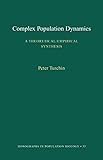Complex Population Dynamics A Theoretical/Empirical Synthesis.
Material type: TextSeries: Publication details: Princeton : Princeton University Press, (c)2013.Description: 1 online resource (471 pages)Content type:
TextSeries: Publication details: Princeton : Princeton University Press, (c)2013.Description: 1 online resource (471 pages)Content type: - text
- computer
- online resource
- 9781400847280
- QH352 .C667 2013
- COPYRIGHT NOT covered - Click this link to request copyright permission: https://lib.ciu.edu/copyright-request-form
| Item type | Current library | Collection | Call number | URL | Status | Date due | Barcode | |
|---|---|---|---|---|---|---|---|---|
 Online Book (LOGIN USING YOUR MY CIU LOGIN AND PASSWORD)
Online Book (LOGIN USING YOUR MY CIU LOGIN AND PASSWORD)
|
G. Allen Fleece Library ONLINE | Non-fiction | QH352 .384 2013 (Browse shelf(Opens below)) | Link to resource | Available | ocn828302490 |
Description based upon print version of record.
Includes bibliographies and index.
Cover; Title; Copyright; Contents; Preface; Mathematical Symbols; PART I THEORY; 1. Introduction; 1.1 At the Sources; 1.1.1 The Puzzle of Population Cycles; 1.1.2 Modeling Nature; 1.1.3 The Balance of Nature; 1.2 General Philosophy of the Approach; 1.2.1 Defining the Phenomenon to Be Explained; 1.2.2 Formalizing Hypotheses as Mathematical Models; 1.2.3 Contrasting Models with Data; 2. Population Dynamics from First Principles; 2.1 Introduction; 2.2 Exponential Growth; 2.2.1 Derivation of the Exponential Model; 2.2.2 Comparison with the Law of Inertia
2.2.3 "Laws": Postulates, Theorems, Empirical Generalizations?2.3 Self-Limitation; 2.3.1 Upper and Lower Density Bounds; 2.3.2 Formalizing the Notion of Self-Limitation; 2.3.3 The Logistic Model; 2.4 Consumer-Resource Oscillations; 2.4.1 Three More Postulates; 2.4.2 The Lotka-Volterra Predation Model; 2.5 Process Order; 2.6 Synthesis; 3. Single-Species Populations; 3.1 Models without Population Structure; 3.1.1 Continuous-Time Models; 3.1.2 Discrete-Time Models; 3.1.3 Delayed Differential Models; 3.2 Exogenous Drivers; 3.2.1 Stochastic Variation; 3.2.2 Deterministic Exogenous Factors
3.3 Age- and Stage-Structured Models3.3.1 Mathematical Frameworks; 3.3.2 An Example: Flour Beetle Dynamics; 3.4 Second-Order Models; 3.4.1 Maternal Effect Hypothesis; 3.4.2 Kin Favoritism Model; 3.5 Synthesis; 4. Trophic Interactions; 4.1 Responses of Predators to Fluctuations in Prey Density; 4.1.1 Functional Response; 4.1.2 Aggregative Response; 4.1.3 Numerical Response; 4.2 Continuous-Time Models; 4.2.1 Generalized Lotka-Volterra Models; 4.2.2 Models Not Conforming to the LV Framework; 4.2.3 Anatomy of a Predator-Prey Cycle; 4.2.4 Generalist Predators; 4.3 Discrete-Time Models: Parasitoids
4.3.1 Functional and Numerical Responses4.3.2 Dynamical Models; 4.4 Grazing Systems; 4.4.1 Grazer's Functional Response; 4.4.2 Dynamics of Vegetation Regrowth; 4.4.3 Dynamics of Grazer-Vegetation Interactions; 4.4.4 Plant Quality; 4.5 Pathogens and Parasites; 4.5.1 Transmission Rate; 4.5.2 Microparasitism Models; 4.5.3 Macroparasitism Models; 4.6 Tritrophic Models; 4.7 Synthesis; 5. Connecting Mathematical Theory to Empirical Dynamics; 5.1 Introduction; 5.2 Qualitative Types of Deterministic Dynamics; 5.2.1 Attractors; 5.2.2 Sensitive Dependence on Initial Conditions
5.3 Population Dynamics in the Presence of Noise5.3.1 Simple Population Dynamics; 5.3.2 Stable Periodic Oscillations; 5.3.3 Chaotic Oscillations; 5.3.4 Quasi-Chaotic Oscillations; 5.3.5 Regular Exogenous Forcing; 5.3.6 Synthesis; 5.4 Population Regulation; 5.4.1 Definition of Density Dependence; 5.4.2 Regulation: Evolution of the Concept; 5.4.3 The Stationarity Definition of Regulation; 5.4.4 Beyond Stationarity: Stochastic Boundedness; 5.4.5 Synthesis; PART II DATA; 6. Empirical Approaches: An Overview; 6.1 Introduction; 6.2 Analysis of Population Fluctuations
6.2.1 The Structure of Density Dependence
Why do organisms become extremely abundant one year and then seem to disappear a few years later? Why do population outbreaks in particular species happen more or less regularly in certain locations, but only irregularly (or never at all) in other locations? Complex population dynamics have fascinated biologists for decades. By bringing together mathematical models, statistical analyses, and field experiments, this book offers a comprehensive new synthesis of the theory of population oscillations.Peter Turchin first reviews the conceptual tools that ecologists use to investigate population osc.
COPYRIGHT NOT covered - Click this link to request copyright permission:
There are no comments on this title.
